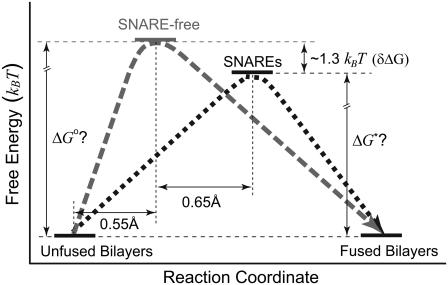FIGURE 3.
Energy landscape of the fusion process in the absence of compression was revealed by our AFM experiments. Based on the transition state theory, the unfused bilayers move along the reaction coordinate toward the fused state, passing through a transition state that is at the peak of the energy barrier. In the presence of cognate v- and t-SNAREs in the apposed bilayers, the energy barrier width was increased and the position of the transition state was shifted to the right by 0.65 Å relative to the SNARE-free bilayers. The height of the energy barrier was also reduced by ∼1.3 kBT. Both changes lead to a reduction in the slope of the energy barrier. A steeper barrier is harder to overcome. Thus, the reduction in the slope of the barrier, effectively, results in a facilitation of the overall process. We interpret the widening in the energy barrier as an increase in the minimal separation distance between the apposed bilayers before fusion can take place. Figure not to scale.

